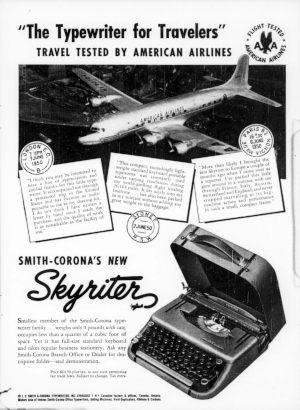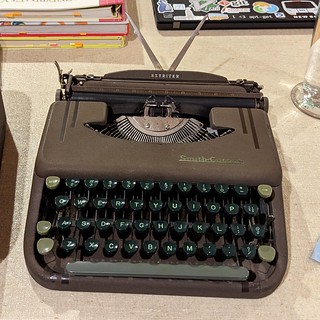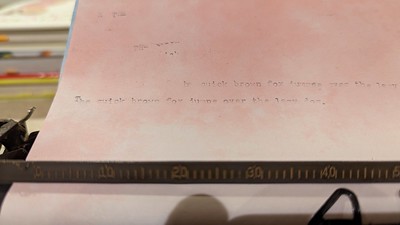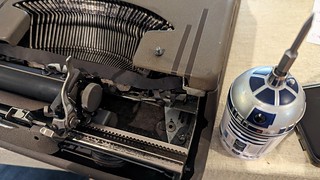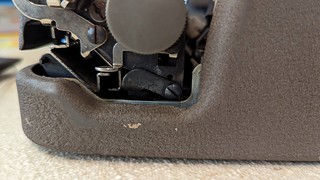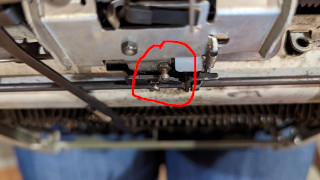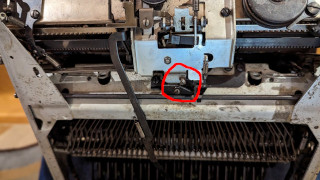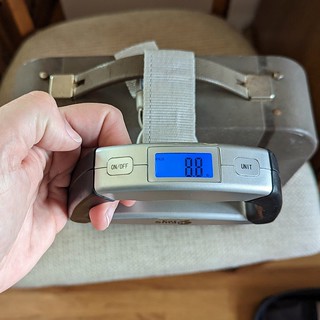I’ve had the book The Typewriter Revolution on my reading pile for a while, but I made my way back to it earlier this year and have put a good dent in it. It’s prompted me to start using writing prompts with my 1938 L.C. Smith-Corona so it gets a bit more use and I have a nice writing outlet. “Unfortunately” the chapter about selecting a typewriter also clued me in to the existence of the Smith-Corona Skyriter. It’s an ultra portable typewriter first introduced in 1949. This is an advertisement that was in an issue of Harper’s Magazine from 1950:
This was the intersection of my new found interest in mechanical typewriters and my love for travel. But I don’t need one, I already have a typewriter, and I already have a Smith-Corona!
But the heart wants what the heart wants.
I read about the Skyriter on January 22nd.
I placed my order for one off of eBay on February 21st.
It arrived on February 25th.
See, I showed a tiny bit of restraint! Almost a whole month!
Now, buying typewriters off of eBay is not the recommended route. The risk for damage is incredibly high, and you really don’t know what you’re getting. Plus, I’d never actually tried it out, I was just purchasing it on a whim. The best way to go about it is finding a local typewriter shop and then working with them to see if they can help you find one. It’s going to be A LOT more expensive than the sticker price on eBay, but chances are you’re going to end up at a typewriter repair shop anyway if you don’t have the time, skill, or interest in fixing and cleaning it yourself. Plus, it’s important to support your local typewriter shop!
That said, I decided that with the simplicity of the Skyriter, I did want to take the time, develop the skills, and take an interest in fixing it up for myself. So for about $100 including tax and shipping, a decent looking Skyriter was on its way to me.
It wasn’t in terrible shape, but it wasn’t great either. Out of the box, the type needed alignment, the space bar had to be pressed very deliberately to space, the roller rail seemed a little crooked, and the carriage would stop and require a strong nudge to continue typing.
The first thing I had to do was learn how to remove it from the bottom half of the case, so I hit YouTube and found Removing Smith Corona Skyriter from Shell Body. Which got me on my way. That allowed me to get a good look at the inside for the first time, and do a first pass at cleaning it. This first pass was just with some canned air and gentle wiping with a damp rag. Indeed, this is the only cleaning I’ve really done so far, a lot of the straight up metal components that hold it together could use a good scrub with soap and water, and I need to do a careful cleaning of some of the more delicate parts, including the strikers. I did manage to find the serial number though, and at 2Y-34249 that makes this a 1950 model (thanks again, typewriterdatabase.com!).
I quickly discovered what was making the roller rail crooked – a screw that was included but wasn’t in actually place (the metal plate it was supposed to go into, it wasn’t). I put that back in place, but I later had to remove it again when I realized that by “fixing” that I had introduced some new alignment issues. I think I finally got it though.
Then I could test what was going on with why the carriage kept stopping at a particular spot on the page. Turns out, the case was bent slightly, which was even more obvious when comparing it to the other side of the case. I gently bent it back into place with my screwdriver and no more getting stuck!
Type alignment was probably the hardest part, and I didn’t fully get it fixed. I couldn’t find documentation on exactly what you should adjust for this, but based on similar typewriters that I watched YouTube videos on, and a little mechanical fiddling, I believe these two screws and nuts are the key to it:
At least, they seem to be the screws that would have an impact on how far it goes up, and when I made adjustments and then went back to typing, it looks like it was making a difference, and it is an improvement:
It’s not 100% for sure. I need to sort out the remaining text alignment issues since the capital letters sometimes strike higher. The space bar still needs a deliberate press, which takes away from the flow of typing on it. It’s much improved though, and usable in the current state. I’ll see what I want to tackle once I finish the next pass of cleaning. It IS a simple typewriter though. As I gaze into the internals of some of the other mechanical standards I’ve seen, I wouldn’t even want to attempt fiddling with some of them. But this typewriter is a nice entry point.
But is it sky ready? Well, I decided against bringing it along on our trip to Philadelphia this week, and let’s be honest, I probably never will travel with it, but while I had the luggage scale out I decided to see if it was indeed 9lbs and hey! Just under!
I wouldn’t be typewriter-free in Philadelphia for long though, a trip to a local typewriter store was already on my schedule.


